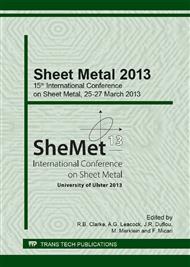p.164
p.172
p.180
p.189
p.197
p.205
p.213
p.223
p.231
Blank Shape Optimization in Sheet Hydroforming Process
Abstract:
Blank shape is one of the most important parameters of sheet metal stamping. In fact it can directly affect the forming quality of parts and it has to be taken in account in sheet hydroforming design. Reasonable blank shape not only can reduce materials and production cost but, also, it can improve the strain distribution of the material and product quality in the hydroforming process. However, it is not easy to find an optimal blank shape because of complexity of deformation behavior and presence of many process parameters like die radius, punch radius, punch speed, blank holder force and friction. In fact, they affect the result of the process i.e. tearing, wrinkling, springback and surface conditions such as earing. Even a slight variation in one of these parameters can result in defects. This paper reports numerical and experimental correlation for axis symmetrical hydroformed component using initial blank with different shape and size. Experimental tests have been carried out through the hydroforming cell tooling, designed by the authors thanks to a research project, characterized by a variable upper blankholder load of eight different hydraulic actuators. Two different initial blank shapes, square and circular, of same material and thickness have been used.
Info:
Periodical:
Pages:
197-204
Citation:
Online since:
April 2013
Authors:
Price:
Сopyright:
© 2013 Trans Tech Publications Ltd. All Rights Reserved
Share:
Citation:


